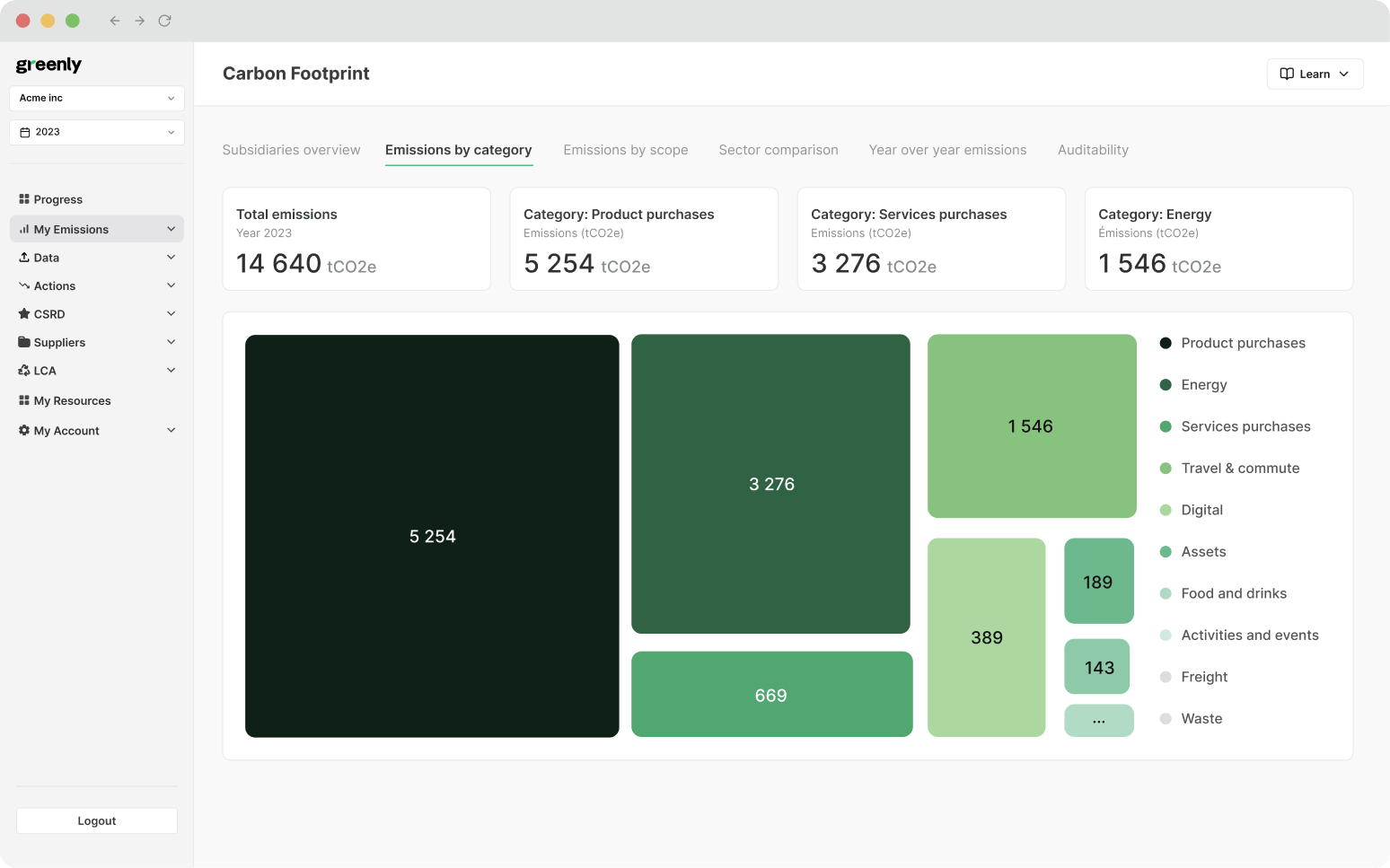
What are the 3 Pillars of Corporate Sustainability?
In this article, we'll explore what the 3 pillars of corporate responsibility are, why they're important, and how businesses can turn them into practical action.
ESG / CSR
Industries



The importance of a sustainability rating
The pros and cons of a sustainability rating
How to improve your current sustainability rating
Sustainability is becoming imperative in the world of business, as customers, investors, and stakeholders are starting to deem things like a sustainability rating as essential when choosing which companies to invest their time and money into.
Sustainability ratings can help companies to be put in a better limelight by demonstrating their efforts towards better environmental and social practices.
What is a sustainability rating, why is it important, and how could it help companies push their businesses forward towards greater financial success and sustainability?
A sustainability rating, also referred to at times as an ESG rating, is a way to measure how businesses or organizations a framework of their overall ESG performances – which can help them to improve their sustainability practices and how their efforts towards sustainability can have an impact on their surrounding communities, stakeholders, and nearby environment.
Sustainability ratings are usually made by rating agencies that seek to use specific indicators to determine the company’s performance in sustainability.
A sustainability rating is important as it helps investors, customers, and employees decide if they want to take part in this company’s product or service – such as investors, consumers, and employees. Besides that, a sustainability rating can help companies to be more transparent with all of those involved in their business endeavors, and also help to provide guidelines for companies that want to become more sustainable – ultimately allowing for a positive influence and encouragement to become more sustainable worldwide.
The overview cards below will reveal why a sustainability rating is important:
A sustainability rating lets people easily compare brands based on environmental performance, not marketing claims.
It reveals what companies normally hide—such as emissions, waste, and resource use—so shoppers can make informed choices.
When businesses know their rating is public, they’re pushed to reduce CO₂ emissions and adopt cleaner practices.
Ratings encourage companies to switch to recyclable materials, reduce packaging, and minimize landfill impact.
People want to support responsible brands—ratings shift demand toward sustainable products and reward good behavior.
Public scoring systems create competition among brands, raising the bar for sustainability across entire industries.
Although demonstrating a company's efforts towards sustainability are one of the key reasons to get a sustainability rating – a sustainability rating can cover much more than that. A sustainability rating usually covers multiple subjects: such as the amount of carbon emissions a company is responsible for, labor practices including DEI, details regarding their supply chain, how the community engages with the businesses, and corporate governance. A sustainability rating could be provided by various frameworks, such as with the Global Reporting Initiative, or GRI for short, the Sustainability Accounting Standards Board, or SASB for short – both of which use different methodologies to arrive at their final sustainability rating.
Ultimately, a sustainability rating is important as the business world starts to recognize the importance of sustainability in cultivating a successful product or service and to satisfy customers, employees, and stakeholders in how the business impacts the environment.

Businesses that acquire a high sustainability rating usually experience a multitude of benefits:
However, a poor sustainability rating could also take a toll on a company’s confidence, reputation, and business performance. A bad sustainability rating could result in the following:
A good sustainability rating could do your company a world of good, but a bad sustainability rating could do you company a world of bad. In a sense, a sustainability rating is a lot like having a good friend. A good friend could support you and make you feel really good about yourself, but a bad friend could cause you to self-sabotage and feel even worse than you did before. A sustainability rating could have the same effect as a good or bad friend can on a human-being.
A sustainability rating is becoming key for companies that want to make headway in the business world, and is pivotal for countries that want to develop a sustainable economy. Companies that choose to partake in the transition to a sustainable economy, and have a good sustainability rating – could bask in the glory of standing out in the market as sustainability ratings rise to prominence.

As the world inches towards greater sustainability, a sustainability rating could help the global economy in a multitude of ways:
Overall, a sustainability rating can help companies to take action and accountability for their current levels of transparency – which can encourage them to improve upon their current circumstances and adapt to a growing and global sustainable economy.

There are many benefits to conducting a sustainability assessment for a sustainability rating, seeing as it can help to influence stakeholders’ decisions, address ESG criteria that needs to be improved, and help to rectify a supply chain in need of a more resilient operational model.
The battle cards below will reveal the pros and cons of conducting a sustainability rating:
However, there can be some difficulties that arise with seeking a sustainability rating. For instance, standardization is one of the biggest issues with sustainability ratings – as many companies will not be assessed to the same degree as another. Think of one student going to a rigorous, private school applying for college against a student from a public school. The level of education is subject to differ – that’s why students in the U.S. often take the SAT or ACT to ensure all students applying for higher education are graded the same way. The same cannot be said for sustainability ratings.
This presents another one of the main issues with sustainability ratings, and it’s that many of them are developed with confirmation bias in mind – deeming the assessment futile from the start. In addition to this, many sustainability ratings have a “jetlag” if you will – as reports for sustainability ratings will often be released long after the sustainability assessment has been completed, leaving the public with a different notion of how a company may be handling sustainability and ESG criteria in the present day. This can lead to undesired greenwashing and a continued lack of transparency, both of which aren’t good for a world trying to become more sustainable.
The interactive flip cards below (move cursor over card to flip) will reveal some of the challenges of acquiring a sustainability rating:
Sustainability ratings are completed with so many different systems (GRI, SASB, DJSI), that it allows for subjectivity. In this sense, sustainability ratings are very similar to high school students trying to apply for college – as it’s unfair to assess students on varying assessment criteria.
However, this isn’t to say that a sustainability rating is useless – and many businesses can still benefit from trying to improve their scores.
Just as with many things in the environmental and carbon accounting world, it is difficult to improve upon your company’s sustainability rating without setting clear goals.
In order of importance, the following should be done for companies looking to improve their sustainability rating:
However, it is important to remember that sustainability ratings are also contingent on those who make a collaborative effort and are associated with your business – with stakeholders being the most crucial in a sustainability rating. The more a business strives to encourage stakeholders to engage, collaborate and effectively communicate with transparency – the better chance a business has at raising their sustainability rating.
An example of a company that improved their sustainability rating is Patagonia, a clothing retailer which has expressed their efforts towards sustainability time and time again – such as by seeking fair labor practices and reducing emissions. Other companies that have also successfully improved their sustainability ratings include Apple and Interface.

Seeing as sustainability ratings are subject to interpretation and lack standardization, it is likely that sustainability disclosures such as the SEC Climate Disclosure Rule, CSRD, or NFRD will start to hold more value over a traditional sustainability rating.


However, it is also probable that with the help of artificial intelligence, such as blockchain technology – that sustainability ratings could finally become standardized.
In order to achieve this, regulators would have to help by providing new guidelines and mandatory frameworks that would align with the future sustainability global standards. Industries would also need to create standard-wide benchmarks to ensure fair sustainability ratings, and the current systems implemented in SASB and GRI would have to acclimate themselves to the new standards as well.
Ultimately, a sustainability rating can help companies to demonstrate their efforts (or lack thereof) towards sustainability – but the system is in dire need of reform if it wants to drive the world towards positive change that sustainability ratings currently aren’t capable of due to their need for standardization.
If reading this article about a sustainability rating has made you interested in reducing your carbon emissions to further fight against climate change – Greenly can help you!
A sustainability rating can be discouraging if it doesn’t come out how you expected it, but fear not– Greenly is here to help you and your business understand how you can improve your sustainability rating and get the business you deserve. Book a demo with one of our specialists to learn more.
Greenly can help you make an environmental change for the better, starting with a carbon footprint assessment to know how much carbon emissions your company produces.
